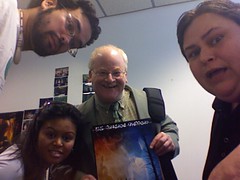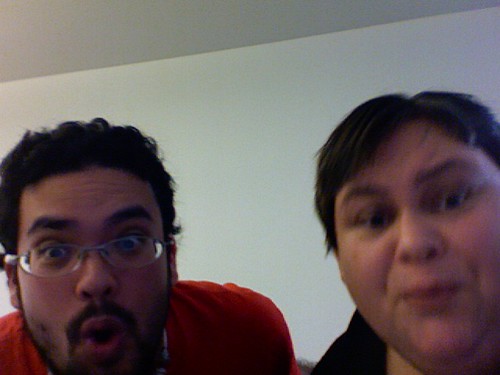Indigeneity and Militarism
Check out the speech below given by Kanak Maoli activist Ikaika Hussey, a student at the University of Hawai'i. Here are two articles about a seven-day protest he organized in 2005 against the intrusion of the United States Navy into the University of Hawai'i.
"Students and faculty oppose Navy research," Friday, April 29, 2005
http://starbulletin.com/2005/04/29/news/story4.html
"UH protesters declare victory as sit-in ends," Thursday, May 5, 2005
http://starbulletin.com/2005/05/05/news/story6.html
******************
 Indigeneity and militarism: aloha aina contra empire
Indigeneity and militarism: aloha aina contra empireIn his book “Imperial Grunts,” U.S. conservative writer Robert Kaplan notes the historic interrelationship between the US wars with the first nations of North America and the modern US imperial experience from Indochina to the present: “Injun Country” is the term which he hears from soldiers abroad in Afghanistan and Iraq, a reference to the undomesticated world which the US aims to tame.
The term is important in two respects. First, it signals the American tendency to see the world outside of North America as subject to its assimiliating tendencies, just as it attempted to do with Turtle Island. In this manner, the anti-Indian wars of the sixteenth through eighteenth centuries are the template for the new Indian wars in Afghanistan, Iraq, and possibly Iran, North Korea, the Mindanao, and China. From this perspective, the unique identities and soveriegnties of the world’s peoples are just open spaces for the projection of US military force, to make way for WalMart, McDonalds, and MTV.
But in another way, the term is important, for it a sign of the resilience and resistance of the world’s peoples against US expansion. In North America, Indian Country has become a way of talking about the places where the US assumes it has control and domination, but the first peoples do not agree. Indian Country is free country – under the jurisdiction of the gun, but still fighting. And so I derive both a sobering appreciation for the power of military power from this term, but also a deeply-rooted faith in the ability for the first peoples of this world, the peoples of the eagle, the condor, and the frigate bird, to sustain our fight against empire, and be victorious in time.
The experiences of indigenous peoples vis-à-vis the militarized empire are multiple and unique. That is, in fact, one of the foundational ideas that indigenous peoples bring to the world: we are not singular, but plural; we obtain our life and very existence from the specificities of our particular ancestors, our particular gods, our named and worshipped sacred sites. As a indigenous person of Hawaii, I can really only speak for myself and my immediate ancestors; I couldn’t casually speak for my next-door neighbors, let alone the peoples of other Oceanic nations, or of the Americas. So in making these remarks, I will try to speak from our own experience in Hawaii, and only by extension refer to other indigenous experiences.
My country, Hawaii, has been under US occupation since the end of the 19th century. US interest in Hawaii is primarily geostrategic. We have the dubious distinction of being used as the headquarters of the Pacific Command, the largest of the U.S. unified commands. In the 161 military installations throughout Hawaii, every aspect of U.S. military activity takes place, including ocean, land, air, and space operations; training; storage; command & control; research; housing; and even specialized rest & recreation facilities for the military. The military-connected population is 17% of the population; by comparison, Native Hawaiians comprise barely 20% of the island population.
On my home island of O‘ahu, the metropolitan island of Hawaii, the US military controls one-quarter of the land in terms of base territory and formal military jurisdiction. Much of the remaining three-quarters is also injected with militarization, with federal highways connecting the bases, discounts for servicepersons in restaurants and theatres, military bases used as place names, military service projects in public schools, and servicepersons living in our communities because of a cost-of-living-adjustment which allows them to outprice local people from the rental market. Oahu is one of the most militarized places in the world, together with fellow Pacific nations such as Guam.
By contrast, to bring out the impact of the military presence on the indigneous economy and culture of Hawaii, let us focus on a place that we have all heard of: Ke Awalau o Puuloa. Many know this place as Pearl Harbor. In our history, Puuloa is known as the food-basket of our islands, with a remarkable series of 36 stone and coral fishponds built along the shore, allowing our people to maintain and replenish a steady supply of fish protein, all within walking distance. In the traditional land apportionment system, each district along the shore of Ke Awalau o Puuloa had access to this incredible resource, because we recognized that this wealth should be shared. Puuloa is also known as the dwelling for our spiritual protector Kaahupahau, a benevolent shark who protected the people of the surrounding Ewa district from other predators.
Juxtaposed against the current (mis)use of Puuloa, we can see how native subsistence wealth has been damaged to make way for US imperial ambitions. Today, Puuloa is a Superfund site, meaning that the Environmental Protection Agency has declared it one of the most polluted areas in the United States. The shared access to the economy of the oceanic resource has also been interrupted, with barbed walls and military police preventing entry to our fishponds.
This story isn’t unique to Puuloa, nor is it unique to Hawaii. At the most recent meeting of the United Nations Working Group on Indigneous Populations, the indigneous delegates considered the impact of militarism on their territories and peoples. Below is a portion of a longer conference report covering a variety of issues; this excerpt is the full text concerning militarism.
[According to indigneous participants,] militarization often involved the use of weapons and vehicles that polluted ancestral and sacred lands, forests and water, and harmed wildlife. Participants expressed their strong opposition to the dumping of toxic military waste, and even nuclear waste, on their lands, which rendered them unproductive and forced people from their traditional lands. Unexploded ordnance and landmines from conflicts or training exercises also contaminated indigenous peoples’ lands and caused injuries, ill-health and even death to the civilian indigenous population.
One issue that was raised frequently by indigenous people during the session was the use of militarization as a pretext to gain control over the natural resources in indigenous traditional lands without adequate compensation. A large number of participants from many different countries and regions cited cases of the use of the military to ensure access to land, minerals, oil and other resources on their ancestral lands.
Indigenous representatives also voiced their opposition to development projects, which they said were used as a justification for controlling areas that belong to their communities, as well as a justification for the presence of large numbers of soldiers on those lands. Many indigenous representatives spoke of long histories of forced resettlement for military use of their lands. Often this was done with neither consultation nor redress.
A number of participants cited the war on terror as a pretext for militarization, in particular in Arab regions. It was noted that a large military presence was often accompanied by human rights abuses by the military, including rape and sexual harassment that disproportionately affected women and children in indigenous communities. Indigenous representatives gave examples of the resulting climate of violence and fear. They cited a number of cases of military forces committing human rights abuses with impunity. Several indigenous participants expressed their concern about military recruitment of indigenous youth, which, they said, was a threat to their way of life. Whilst in some cases, recruitment might appear to be voluntary, indigenous youth who were living in poverty might see military service as their only option to earn a living.
As you see, the themes raised by indigneous nations are familiar to many of us in this conference. Clearly, many nation-states regard indigneous rights as a lesser right to the interests of developers or the military – this tendency is an example of a recurring problem that indigenous peoples face, which is the reluctance and often outright refusal for states to recognize indigneous land and sovereignty claims. The international law doctrine of self-determination, enshrined in the United Nations charter and in human rights instruments, is poorly applied, if at all, to indigneous peoples. Our movement for demilitarization and peace must be cognizant if this fact. It would also be appropriate to remind the body of the lessons learned in the Pacific, where some in the Nuclear Free Pacific movement objected to the tendency for the Pacific Islanders themselves to raise the issue of decolonization and independence. The natives demanded that demilitarization be coupled with a push for sovereignty, thus the name Nuclear Free & Independent Pacific was born. But this was indeed a line struggle, painful yet necessary.
Aloha Aina
In closing, I’d like to share our indigenous term for describing our movement in Hawaii. We use the words “aloha aina,” literally “love of land,” but also meaning patriotism. It is a word that was born out of the late-19th century struggle against annexation, and was also reinvigorated with meaning in the 1970s movement to stop the bombing of Kahoolawe island. The term also incorporates a vision for ecological sustainability, for community, and shared responsibility for our island homeland. We could never accept the harming of the land which have so much “aloha” for. Nor could we countenance the use of our land, which is the source of all life, to perpetrate violence on others. Our vision is for an independent Hawaii and a demilitarized Pacific that opposes all empires.
Mahalo nui, aloha aina.
Labels: Hawai'i, Imperialism, Kanaka Maoli, Militarism











